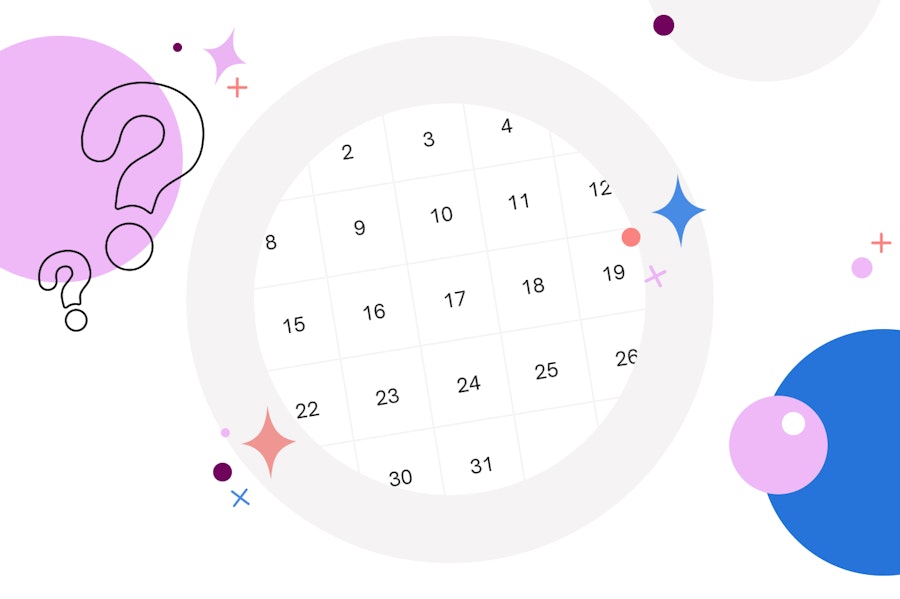How long does ovulation last?
When does ovulation occur?
The simple answer: ovulation occurs roughly two weeks after your period starts. However, every body is different, and your exact ovulation day will vary depending on your cycle length and other factors, such as stress or if you have a condition such as PCOS or endometriosis. Other factors aside, ovulation theoretically happens around halfway through the cycle.
Signs ovulation is coming
Human beings are different to most other animals in that our ovulation is hidden. You can’t look at someone and see that they are ovulating! However, if you know your own body, and the signs to look out for, you might be able to predict ovulation is on its way. One way to do this is by monitoring your cervical mucus. This discharge changes throughout the cycle but is more abundant and changes in consistency in the days leading up to ovulation.
You might also notice some other changes, too. For example, that you have more energy, or that you’re in a better mood in the lead-up to ovulation. Some people also notice their libido increases in this fertile time frame. These physical and emotional changes are linked to the hormone estrogen, which is highest in the preovulatory phase of your cycle.
Keep in mind that relying on these signs alone isn't a guarantee that you’re ovulating. There are many things that can cause changes to mood or energy levels, and interpreting cervical fluid is tricky without proper training, as vaginal discharge can be influenced by many different factors.
However, there are other ways to find out when you’re ovulating. In fact, there’s a link between our body temperature and our fertile window that could be the key to unlocking your fertility.
Tracking basal body temperature to find the fertile window is nothing new, but Natural Cycles offers a contemporary way to predict and confirm ovulation, in the form of a temperature-based app. Users measure their temperature, either by wearing a device overnight or with an oral thermometer in the morning. The app’s algorithm learns the pattern of the cycle and is therefore able to detect the fertile window. This certified birth control method can be used to both plan or prevent pregnancy, depending on your fertility goal.
As well as measuring temperature, you can also buy ovulation tests. These measure the presence of luteinizing hormone in your urine and can indicate if ovulation is about to occur. You can use these tests alongside the Natural Cycles app to give the algorithm a boost, but they are completely optional!
Signs ovulation is over
In the days following ovulation, cervical mucus dries up. On the hormonal side of things, estrogen levels drop while progesterone levels remain high. This hormonal shift can lead to the symptoms associated with PMS, such as tiredness or tender breasts.
Keep in mind that some of these changes are also symptoms of early pregnancy, so it can be hard to tell the difference if you’re trying for a baby! If you think you might be pregnant, the best time to take a pregnancy test is on the first day of your missed period.
When it comes to confirming ovulation, you don’t need to leave things to guesswork! If you’re using Natural Cycles, the app will confirm your ovulation day once there are several high temperatures entered in a row. Finding ovulation can take a little longer in your first few cycles, but should get faster as the algorithm gets to know your unique cycle.
How many days after ovulation will I get my period?
Providing you’re not pregnant, you can expect your period to arrive roughly two weeks after ovulation. Again, this will vary from person to person depending on the length and regularity of your menstrual cycle.
Tips for getting pregnant on ovulation day
Now you know that ovulation only lasts for a maximum of 24 hours, that can feel like a lot of pressure to time sex correctly! However, the good news is that your fertile window is longer than a single day, and thanks to sperm survival, you can still get pregnant even if you have sex a few days before you ovulate. This is because sperm cells can live in the female reproductive system for up to five days at a time.
Providing you have sex once within this six-day window in your cycle, you have a chance of getting pregnant (that’s right, you don’t have to do it every single day)! However, to maximize your chances of successfully conceiving, it’s best to have sex a day or two before you ovulate, as this gives the sperm a chance to move towards the egg cell — so they are ready and waiting to meet the egg when ovulation does happen.
Get pregnant faster with Natural Cycles
Thanks for reading up on the ovulation window! Our research has shown that on average, those who use Natural Cycles get pregnant in three cycles.
Whether you’re looking to use natural birth control until you’re ready to start a family, or want to start planning a pregnancy straight away, our FDA Cleared app is here to understand the pattern of your unique menstrual cycle, and help you find your most fertile days.
Did you enjoy reading this article?
